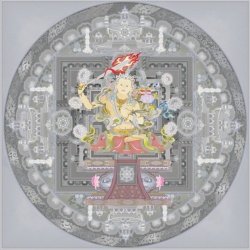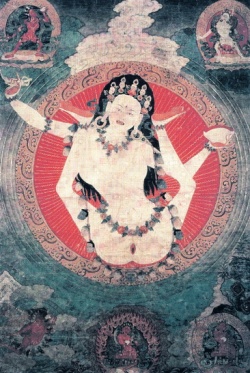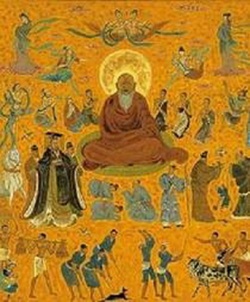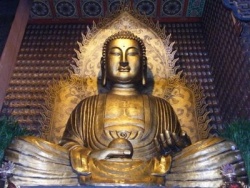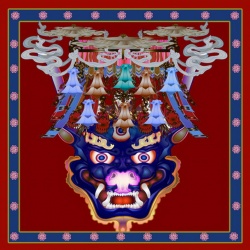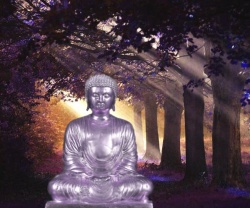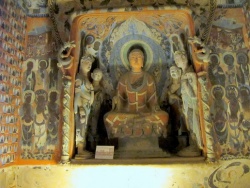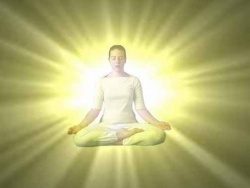Lay Practices
The essay in this chapter was taken from Holmes Welch, The Practice of Chinese Buddhism, 1900. 1950 (Cambridge, MA: Harvard University Press, 1967), 357.66. Copyright c 1967 by the Presidents and Fellows of Harvard College. Reprinted by permission of Harvard University Press.
Lay Identity and
Participation (China)
In the introduction to chapter 5, we noted that many Buddhist texts and traditions state that the ideal Buddhist community is composed of an order of monks (bhiksus), an order of nuns (bhiksunis), a segment of laymen (upasakas), and a segment of laywomen (upasikas). As we have already seen from several examples, the renunciant communities have played an important role in Buddhist life. However, as has been suggested in several of the preceding chapters, laymen and laywomen have also been integrally involved. In fact, most Buddhist communities have typically given the lay vocation an essential and respected role. Further, certain exceptional cases in recent Buddhist history in Japan and China notwithstanding, most Buddhist communities have positioned the lay vocation within the context of a symbiotic relation with the monastic vocation. In the next five chapters we will explore certain aspects and dimensions of the lay religious life and how certain aspects of that life relate to the monastic one.
Typically, Buddhist lay communities are guided by various sets of precepts and injunctions, which are designed to inspire and cultivate a number of personal, devotional, and social attitudes. They are meant to inspire a sense of honor, awe, and reverence toward the Buddha, dharma, and samgha. They are also meant to assuage, limit, and control excessive desire, anger, fear, hatred, anxiety, and frustration. Finally, they
1. Editorsf note: The author of this article has adopted sangha rather than samgha as the term designating the Chinese Buddhist monastic community. are meant to encourage good and proper social relations and interactions, including those between oneself and onefs family and between oneself and the wider society and world.
The following excerpt concerns lay Buddhist precepts and injunctions as they appeared in China several decades before the triumph of communism. It is especially compelling in its portrayal of the establishment of nonmonastic forms of Buddhist identity as well as different types and degrees of lay commitment and practice.
Holmes Welch
First of all, we have to decide what a lay Buddhist is. If we were preparing a census questionnaire for use in China, how would we phrase the entry on religion? This is not a hypothetical problem. The director of the 1961 census in Hong Kong was unable to solve it and therefore no entry on religion was included. Suppose we asked: gDo you believe in the Buddha ?h In that case most of the rural population of China would answer in the affirmative, because to them fo (buddha) and pfu-sa (bodhisattva) are terms that can be loosely applied to all divinities, Buddhist, Taoist, and even Christian.
If we asked: gDo you go to worship at Buddhist temples?h almost all would answer that they did, although they might add that they worshipped at other temples too. It would not help to inquire whether they called in Buddhist monks to perform rites for the dead, since this was done even in strict Confucian families that would normally have no traffic with the sangha.1 On the other hand, if we said gAre you a Buddhist (fo-chiao tfu)?h we would find that instead of some claiming to be Buddhists who were not, there would be some claiming not to be Buddhists who were. This is partly because the term gBuddhisth has a little stronger connotation in Chinese than it does in English and partly because, as Gamble discovered, ga man will usually claim that [[[Wikipedia:Confucianism|Confucianism]]) is his religion, even though he believes in others as well.
There are two questions, however, to which the answer would be revealing: gHave you taken refuge in the Three Jewels?h and gHave you taken the Five Vows?h All who answered either of these questions affirLAY
2. Editorsf note: Kuan-yin is a feminized version of Avalokitesvara, the great bodhisattva of compassion, that developed in China.
matively would be likely to have a clear idea of Buddhism as a distinct religion and to have decided that they belonged to this religion rather than to any other. They would acknowledge that they were gBuddhists,h since they had become the disciples of the Buddhist monk with whom they took the Refuges.
If they had taken the Five Vows, they would also say that they were yu-pfo-sai (male) or yu-pfo-i (female), terms transliterated from the Sanskrit upasaka and upasika. Bhiksus and bhiksunis, upasakas and upasikas, are the four groups that make up the Buddhist community. A somewhat broader term is gdevoteeh (chu-shih), literally ga person who resides [at home].h gDevoteesh include not only devout laymen who have taken the Refuges or Five Vows, but those who are merely scholars and friends of Buddhism. Indeed it can be loosely applied as a title of courtesy to anyone who has any interest in Buddhism whatever. But it would not be applied to the peasant woman who offers incense to Kuan-yin in hopes of bearing a son.
This would be because, although she might be more devout than most devotees, she does not distinguish the Buddhist religion from any other. She has no affiliation with it. Such a woman, like the Confucian official who has a Buddhist service performed for his parents, might best be called an goccasional Buddhist.h In the sections that follow, there will be an effort to keep the reader clearly informed as to what category of lay person is under discussion. First let us consider the formal steps by which affiliation with Buddhism was celebrated. The first step, taking the Refuges, meant that the lay person declared his faith in the Buddha, the dharma, and the sangha. The second step, taking the Five Vows, meant that he promised not to kill, steal, lie, drink alcoholic beverages, or commit any immoral sexual act. The third step, taking the Bodhisattva Vows, meant that he was committed to followthe bodhisattva path in helping and saving all other creatures. These three steps could either be separated over the years, or be taken close together in a brief period.
Taking the Refuges
When the Refuges were administered by a monk to a layman, the effect was to make the layman the monkfs disciple, that is, his Refuges disciple (kuei-i ti-tzu) and hence formally a Buddhist (fo-chaio tfu). Taking the
Refuges might be compared to baptism and confirmation together. A monk did not become the Refuges disciple of another monk, or a layman of a layman.
The layman prostrated himself as he recited the Refuges and received a religious name from the monk exactly as he would if he were entering the sangha. The name included a character, which was the same as the one received by his masterfs tonsure disciples. The latter, therefore, could be considered his gbrothers.h Unlike tonsure, however, the Refuges could be taken over and over again with different masters or with the same master. Like most master-disciple relationships, it was not exclusive.
These features were universal. Others varied. Usually, for example, the disciple repeated with his own lips the formula: gI take refuge in the Buddha, I take refuge in the dharma, I take refuge in the sangha.h Sometimes, however, he stood in silent assent while the master pronounced the formula on his behalf. This was the procedure, for example, when the Venerable Yueh-hsi administered theRefuges to a crowd of four hundred persons gathered in the park of the Seventy-two Martyrs in Canton before the Second World War. Afterwards they filed past and he gave each a slip of paper with their religious names. He did not give out certificates, however. This may have been because he was old-fashioned or because of the size of the crowd. Certificates became increasingly common during the Republican period (1912.1949), perhaps as a countermeasure to the baptismal certificates handed out by the Christian missionaries.
Termed san-kuei cheng-shu, kuei-i cheng, or kuei-i tieh, they stated that So-and-so of such-and-such a place has this day taken the Refuges under Reverend So-and-so,h whose signature was affixed below. Usually the text of the certificate admonished the disciple to do nothing evil, but good to all, and in particular, to forsake other religions. For example, one certificate lists the following prohibitions: gIf you take refuge in the Buddha, you may no longer take refuge in other religions, whether they deal with Heaven or demons, for they do not provide escape from the cycle of birth and death. If you take refuge in the dharma, you may no longer accept the scriptures of other religions, for their principles do not reflect the true reality. If you take refuge in the sangha, you may not become the disciple of a master who belongs to another, heterodox religion, because that would be the blind leading the blind.h I have never seen a Refuges certificate from the Chfing period (1644 .1912) and I do not know whether they were marked by the same sort of exclusivism. Usually the Refuges were administered to a group, but it could just
as well be done individually. One of my lay informants went to get them from the Venerable Yin-kuang. He found the great Pure Land monk in sealed confinement, and the ceremony was performed through a wicket. Yin-kuang recited the formulae and my informant repeated them after him. Next came a short explanation, and finally he was handed his Refuges certificate. Another informant, who was unable to go to Yinkuang to take the Refuges in person, applied by letter. He soon received a certificate, already filled out, together with instructions on what to do with it. He was to place it in front of the Buddha image at home, make three prostrations, recite the formulae, and then make three more prostrations. Having done this, he could consider himself Yin-kuangfs disciple. Later he took the Refuges with the abbot Hsu-yun in exactly the same way, except that a monk he knew acted as his sponsor, asking for the favor by letter and presumably assuring Hsu-yun that he was a worthy applicant.
Most masters felt little concern for worthiness. What concerned them was the opportunity to make another convert. One monk told me with pride that he had administered the Refuges to over two hundred persons. In most cases, he admitted, it had been in the form of gexpedient Refuges,h that is, with a simplified version of the ceremony. I was present when he made such a convert. A young woman had come to the monastery for an outing. She got into conversation with my informant, who soon suggested that she ought to take theRefuges. She seemed reluctant, so he gave her a five-minute sketch of the Buddhafs life. To clinch his argument he pointed out that Buddhism was not superstitious and was being studied by foreign scholars like this American who was listening to them.
Perhaps out of politeness she appeared to find the last argument irresistible. We were standing at the time some distance from the monastery buildings. He had her recite the formulae gI take refuge . . .h and bow to the south after each sentence. (I asked why the south and was properly reminded that the Buddha nature was everywhere.) Then he gave her a little talk on her future conduct. She was not to worship any popular divinities and she was to try to eat a little less meat and to avoid killing animals at home. Finally he took her name and address so that he could send her the Refuges certificate. Such a gconversionh should not be laughed off. A seed was planted: perhaps it grew. But it is certainly fair to say that this first step in the lay Buddhist career was not necessarily an important one. While some devotees only took it after a long study of Buddhist doctrine, for other disciples it made their goccasional Buddhismh only a little less occasional.
3. Many certificates had borders composed of three rows of tiny circles. A circle was burned each time the holder recited a text or buddhafs name. When the border was completely burned, the certificate could serve as a passport through hell and was often placed in his coffin.
4. Editorsf note: Tfai-hsu was the leading figure in the modernist Buddhist reform movement that developed in China during the early decades of the twentieth century. Their master might write to them from time to time asking for money. They were usually glad to send it, since it made them feel that some of the merit he was accumulating by his pure life would be transferred to them. If he were a great abbot, like Hsu-yun, even the indifferent Buddhist would take great pride in the connection he had established by becoming his disciple. But pride too can start people along the path to enlightenment.
Lay Ordination
If the Three Refuges were an initiation, the Five Vows were an ordination. They were usually administered in a monastery as part of an ordination of monks. The ceremony was elaborate and solemn, and at the end of it a lay gordination certificateh was conferred.3 Serious obligations resulted. The devotee who took the vow against killing could not, for instance, hunt or fish. So seriously were the vows looked upon, in fact, that not all five were necessarily taken. When one or two were taken, it was called a gminor ordination (shao-fen chieh).h When three or four were taken, it was called a gmajor ordination (to-fen chieh).h When all five were taken, it was called a gplenary ordination (man-chieh).h In the printing of some lay ordination certificates, a space was left before the word fen, which could be filled in to show which of these three categories the holder belonged to. A businessman, for example, might be reluctant to take the vows against lying and stealing, since this would interfere with the conduct of his business. A person who felt unable to forgo the pleasures of the gflower househ would omit the vow against sexual license. Almost everyone, however, included the first vow: not to take the life of any sentient being. It may be argued with some force that if the Five Vows were a mere form, there would not have been such scrupulousness in taking them.
An increasing number of male devotees took the Five Vows outside monasteries during the Republican period. Tfai-hsu, for example, administered them to four hundred members of the Right Faith Buddhist Society in Hankow in 1929.4 The ceremony was held at the
5. Here at Nan-hua some preferred to burn six marks, some nine. At Pao-hua Shan, according to one informant, the lay ordination always involved nine scars, burned on the head, not on the arm. In his description of this monastery Prip-Moller agrees that they were burned on the head, but states that in the case of women, at any rate, there were Societyfs headquarters. Those being ordained first recited the Three Refuges (many of them for the first time) and then, kneeling, responded to Tfai-hsufs catechism. gCan you accept the prohibition against killing living creatures?h he asked the assembly. All those who were prepared to undertake this answered
I can,h and prostrated themselves. Even some of those who were not undertaking it prostrated themselves, although there would have been no embarrassment if they had simply remained on their knees (or so my informant said). After the other vows had been administered, everyone received a certificate bearing his religious name as well as his surname, domicile, age, and so on.data taken from a form that they had filled out ahead of time. More typical instances are provided by an informant who took the Three Refuges and the Five Vows under the Venerable Hsu-yun on two occasions several years apart. The first time was in Chunking during the war. A great crowd had gathered, perhaps four to five thousand persons. They were packed together so close that it was impossible to kneel or even to bow as they accepted the vows, which were relayed to them by monks standing in different parts of the field where they were assembled. According to my informant, another crowd of the same size took the vows on the following day and again on the day thereafter.
Ten to twenty thousand people became disciples of Hsu-yun in those three days,h he said. This caused a delay in the delivery of their ordination certificates, which they came back to collect a week later. Perhaps because he felt that this sort of mass ceremony was too casual, my informant took the Five Vows under Hsu-yun again, this time at the Nan-hua Ssu, Kwangtung, in 1949. The procedure was largely the same as at other large monasteries. The lay ordinees arrived at the beginning of a regular ordination of monks and nuns, and took the Three Refuges and the Five Vows on the same day that the novices took the Ten Vows. Many stayed on while the novices went through the second part of the triple ordination, and then took the Bodhisattva Vows during the third part. The night before they performed the same penance as the monks and nuns and during the actual ordination they left the hall only when the latter recited the articles of the Fan-wang ching. Whereas the monks and nuns were burned on the scalp, the lay ordinees were burned on the inner side of the forearm.three scars or more.
only three, burned in a small square shaved on the middle of the scalp. An informant from Peking had only one scar burned and said that this was common there, perhaps because piety was at a lower pitch than in central China. Scars on the forearm would have the advantage of being visible evidence of the ordeal, whereas those on the head would be covered by hair. On the other hand, none of the four hundred persons who received the lay ordination from Tfai-hsu at the Right Faith Buddhist Society in Hankow had any scars burned at all. Tfai-hsu is said to have considered it gsuperficial.h They too received ordination certificates (with a different text) and their names were printed at the end of the ordination yearbook. There was no fixed charge for all this.
Most of the lay ordinees made whatever donation they felt they ought to, considering the fact that they had been living in the monastery for a couple of months. The rich might give the equivalent of one or two hundred silver dollars. Some devotees who took the Three Refuges did not go on to take the Five Vows. Some who took the Five Vows did not go on to take the Bodhisattva Vows. The relationship between those three principal steps in the lay Buddhist career is controversial. Several lay informants have insisted that the Three Refuges were never taken alone, but always in conjunction with the Five Vows. Other informants had themselves taken the Three Refuges alone. It was common to do so in a local hereditary temple under one of its heirs, and then after a few years had passed, to go to a large monastery and take the Five Vows in a group organized by onefs master.
I have found similar disagreement as to whether a majority of lay people who took the Five Vows did or did not go on to take the Bodhisattva Vows. On the whole, it seems that they usually did if they went to a monastery for ordination, although there was no obligation to do so. If, however, they went to a secular place of ordination (like a lay Buddhist association) the Bodhisattva Vows were usually omitted. In general the monastery ordinations were far more impressive.
The layman who kneeled for a few minutes one morning in an auditorium cannot have felt so fully initiated as the layman who had spent two months in a secluded monastery, studying with the monks-to-be, drilling with them in the courtyard, taking part in the same night-long vigils, and burning scars onto various parts of the body (especially the scalp and forearm). Furthermore, they emerged feeling a connection with the ordaining establishment. One devotee described himself as an gheirh of the monastery where he had been ordained. He was speaking loosely, of course, because he had acquired no proprietary rights whatsoever. On the other hand, he had undoubtedly become an gordination discipleh of that monastery as much as any of the monks ordained there at the same time. Ordination disciples could.like Refuges disciples. be approached for support if it was needed.
Observance of the Lay Vows
The Bodhisattva Vows formalized the lay resolve to follow the bodhisattva path and to help all living creatures. Taken word for word, they did not appear to add a great deal to the Five Vows already accepted. Most of my informants, however, maintained that they added the obligation to be a vegetarian. The first of the Five Vows, they said, meant simply to avoid killing animals oneself or eating an animal that had been killed on onefs account, while the Bodhisattva Vows forbade contributing in any way to the use of animal products.
Other informants, on the whole better qualified, took a different view. They maintained that the first of the Five Vows carried with it the clear obligation to become a vegetarian. They were quite indignant at the idea that this obligation arose only from the Bodhisattva Vows. There was a similar difference of opinion about sexual abstinence.
All informants agreed that the third of the Five Vows (against illicit sexual activity) prohibited visits to a brothel or even intercourse with onefs wife in an improper place at an improper time or with the use of instruments (gimproperh meaning, for example, in the living room during the afternoon, which, I was told, has been in vogue among those of modern outlook). But some informants said that a devotee who had taken the Five Vows was required to put away his concubines. Others said that he was merely prohibited from taking additional concubines. Still others maintained that these restrictions did not begin until he had taken the Bodhisattva Vows. One upasaka I know, who had not taken the latter, avoided intercourse with his wife when its purpose was to satisfy sexual desire. He only had relations to beget children and, he said, children begotten without sexual desire were always superior. I have heard of devotees (though my informants were not among them) who avoided sex and animal food on holy days like the festivals of Kuan-yin and the 1st and 15th of the lunar month. There was obviously a wide variety of interpretation and practice.
Breaking the vows was distinguished from suspending or gopeningh them. In the treatment of some illnesses, for example, the doctor would prescribe eggs or wine. In that case the upasaka could consume prohibited foods with a clear conscience. Nor did his conscience trouble him if he violated the vows he had not taken. It was up to each individual how far he wanted to go in abstinence and how much merit he wanted to accumulate. As one devotee remarked: gThere is nothing embarrassing in being unprepared to give up sexual immorality. The embarrassing thing would be to take the vow and then not to carry it out.h Some lay people practiced abstinence without any formal ordination. One informant, for example, had been afflicted with eye trouble since she was a child. It was suggested that she promise to become a nun if the affliction were healed. When her grandfather vetoed this proposal, she and her two sisters promised instead a vegetarian meal on the twentieth of every month for the rest of their lives. Her eyes did improve and so every twentieth they ate vegetarian food, dedicating the merit arising therefrom to repay the merit transferred by the bodhisattva to bring about the cure.
Figure 11. The Lord of Death clutches the round of rebirth in a mural at Thikse Monastery, Ladakh. Photograph by Matthew T. Kapstein.
The essay in this chapter was taken from Rebecca Redwood French, The Golden Yoke: The Legal Cosmology of Tibet (Ithaca, NY: Cornell University Press, 1995), 61.67. Copyright c 1995 by Cornell University. Used by permission of Cornell University Press.
